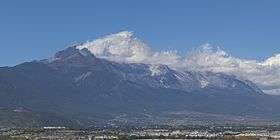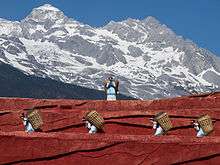Jade Dragon Snow Mountain
| Jade Dragon Snow Mountain | |
|---|---|
 Jade Dragon Snow Mountain towering over nearby Lijiang | |
| Highest point | |
| Elevation | 5,596 m (18,360 ft) |
| Prominence |
3,202 m (10,505 ft) [1] Ranked 71st |
| Isolation | 141 kilometres (88 mi) |
| Listing | Ultra |
| Coordinates | 27°05′54″N 100°10′30″E / 27.09833°N 100.17500°ECoordinates: 27°05′54″N 100°10′30″E / 27.09833°N 100.17500°E [1] |
| Geography | |
 Jade Dragon Snow Mountain Yulong Naxi Autonomous County, Yunnan | |
| Parent range | Yulong Mountains |
| Climbing | |
| First ascent | 1987 by Phil Peralta-Ramos and Eric Perlman[2] |
| Easiest route | East side: snow/rock climb[2] |
Jade Dragon Snow Mountain (simplified Chinese: 玉龙雪山; traditional Chinese: 玉龍雪山; pinyin: Yùlóng Xuěshān) is a mountain massif or small mountain range in Yulong Naxi Autonomous County, Lijiang, in Yunnan province, China. Its highest peak is named Shanzidou (扇子陡) and is 5,596 m (18,360 ft) above sea level.
Etymology
The Chinese name, Yulong Xueshan, translates directly as Jade Dragon Snow Mountain. The same is sometimes translated as Mount Yulong or Yulong Snow Mountain.[3] The mountain's Naxi name is Mount Satseto.[4]
Geography
The Jade Dragon Snow Mountain massif forms the bulk of the larger Yulong Mountains, that stretch further north. The northwestern flank of the massif forms one side of the Tiger Leaping Gorge (Hutiao Xia, 虎跳峡), which has a popular trekking route on the other side. In this gorge, the Jinsha (upper Yangtze) River descends dramatically between Jade Dragon and Haba Snow Mountain. The Yulong Mountains lie to the south of the Yun Range and are part of Southwest China's greater Hengduan Mountains.[5]
Settlements surrounding Jade Dragon Snow Mountain include Baisha Town to the south, Longpan Township to the west, Daju Township to the northeast, and Jade Water Village at the foot of the mountain to the east.
Exploration history
Shanzidou has been climbed only once,[6] on May 8, 1987, by an American expedition. The summit team comprised Phil Peralta-Ramos and Eric Perlman. They climbed snow gullies and limestone headwalls, and encountered high avalanche danger and sparse opportunities for protection. They rated the maximum technical difficulty of the rock at YDS 5.7.[2]
The Austro-American botanist and explorer Joseph Rock spent many years living in the vicinity of Mt Satseto, and wrote about the region and the Naxi people who occupy it. An interest in Rock later drew the travel writer Bruce Chatwin to the mountain, which he wrote about in an article that appeared in the New York Times[7] and later, retitled, in his essay collection What Am I Doing Here?.[8] Chatwin's article inspired many subsequent travellers, including Michael Palin,[9] to visit the region.
Tourism

The view of the massif from the gardens at the Black Dragon Pool (Heilong Tan) in Lijiang is noted as one of China's finest views. The mountain is part of Yulong Snow Mountain National Scenic Area and National Geological Park, an AAAAA-classified scenic area.[10] The Park operates a tourist cable car that elevates to 4,680 m (15,350 ft) for close views of the snow peak, which is criticized for accelerating the melting of the snow and reducing the water retention by the mountain.
The mountain was featured on Episode 4 of The Amazing Race 18.
 Yak and cascading pools with the mountain in the background
Yak and cascading pools with the mountain in the background View of Jade Dragon Mountain
View of Jade Dragon Mountain- Yulong Snow Mountain Waterfall
 Glacier on top of the mountain
Glacier on top of the mountain Yunnan Black-Dragon-Pool
Yunnan Black-Dragon-Pool- A view approximately 900m below the summit
References
| Wikimedia Commons has media related to Jade Dragon Snow Mountain. |
- 1 2 "China III - Sichuan and Yunnan Provinces". Peaklist.org. Retrieved 2014-08-25.
- 1 2 3 Eric S. Perlman, "Yulong Shan", American Alpine Journal, 1988, p. 265.
- ↑ Zongxing Li. Study on Climate Change in Southwestern China. Springer Science+Business Media. p. 57. ISBN 978-3-662-44741-3. ISSN 2190-5053. LCCN 2014951737.
- ↑ "Yunnan's Ancient Cities: Dali-Shaxi-Lijiang". Exotissimo. Retrieved December 13, 2012.
[Jade Dragon] mountain, also called Satseto in the Naxi language, takes its name from the God of War in the Dongba religion.
- ↑ Atlas of China. Beijing, China: SinoMaps Press. 2006. ISBN 9787503141782.
- ↑ Tamotsu Nakamura, "East of the Himalaya", American Alpine Journal, 2003, p. 146.
- ↑ Chatwin, Bruce. "In China, Rock's Kingdom", New York Times, March 16th 1986
- ↑ Chatwin, Bruce (1989) "Rock's World", in What Am I Doing Here?, Vintage, p.206
- ↑ Palin, Michael (2005) "Himalaya - Day 82: Lugu Lake to Lijiang", Retrieved 2011-01-13
- ↑ "AAAAA Scenic Areas". China National Tourism Administration. 16 November 2008. Archived from the original on 4 April 2014. Retrieved 9 April 2011.